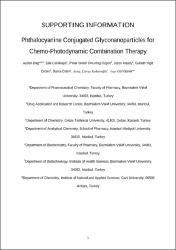| dc.contributor.author | Daǧ, Aydan | |
| dc.contributor.author | Çakılkaya, Eda | |
| dc.contributor.author | Omurtag Özgen, Pınar Sinem | |
| dc.contributor.author | Atasoy, Sezen | |
| dc.contributor.author | Yiğit Erdem, Gülşah | |
| dc.contributor.author | Çetin, Büşra | |
| dc.contributor.author | Çavuş Kokuroǧlu, Aytaç | |
| dc.contributor.author | Gürek, Ayşe Gül | |
| dc.date.accessioned | 2021-04-26T06:38:36Z | |
| dc.date.available | 2021-04-26T06:38:36Z | |
| dc.date.issued | 2021 | en_US |
| dc.identifier.citation | Daǧ, A., Çakılkaya, E., Omurtag Özgen, P. S., Atasoy, S., Yiğit Erdem, G., Çetin, B. ... Gürek, A. G. (2021). Phthalocyanine-conjugated glyconanoparticles for chemo-photodynamic combination therapy. Biomacromolecules, 22(4), 1555-1567. https://dx.doi.org/10.1021/acs.biomac.0c01811 | en_US |
| dc.identifier.issn | 1526-4602 | |
| dc.identifier.uri | https://dx.doi.org/10.1021/acs.biomac.0c01811 | |
| dc.identifier.uri | https://hdl.handle.net/20.500.12511/6767 | |
| dc.description.abstract | Combination cancer therapy based on multifunctional nanomaterials has attracted great attention. The present work focuses on the preparation of the glycopolymeric nanoparticle, which contains a photosensitizer (zinc(II)phthalocyanine, ZnPc) and an anticancer drug (Doxorubicin, Dox). First, a novel mono azide-functional ZnPc-N3 with seven hydrophilic ethylene oxide chains was synthesized. Next, ZnPc alone or together with Dox bearing glycopolymers was synthesized via the RAFT polymerization method and then self-assembled into glyconanoparticles (GNPs) with narrow particle size distribution. Then the evaluation of the biological activity of GNPs (GNPs-ZnPc and GNPs-ZnPc/Dox) for dual photodynamic therapy (PDT) and chemotherapy against human breast cancer cells was investigated. The constructed GNPs were identified via general characterization methods, including dynamic light scattering (DLS) and transmission electron microscopy (TEM). The prepared GNPs-ZnPc/Dox demonstrated remarkable photophysical and photochemical properties, involving good colloidal stability in biological conditions, pH-responsive drug release, and the capacity to generate singlet oxygen under light irradiation. The outer layer of nanoparticles covered by fructose sugar moieties achieves a targeted cancer therapy owing to GLUT5 (a well-known fructose transporter) overexpression toward breast cancer cells. In vitro experiments were then performed to evaluate the chemo/phototoxicity, cellular uptake, and anticancer efficacy of GNPs-ZnPc/Dox. In comparison with free Dox, human breast cancer cells treated with GNPs-ZnPc/Dox exhibited a higher cellular internalization via GLUT5 targeting. In particular, the GNPs-ZnPc/Dox nanoplatform revealed an excellent synergistic anticancer activity in comparison with free ZnPc-N3 and free Dox, representing a novel and promising chemo-photodynamic combination therapeutic methodology to improve therapeutic efficacy. | en_US |
| dc.language.iso | eng | en_US |
| dc.publisher | NLM (Medline) | en_US |
| dc.rights | info:eu-repo/semantics/embargoedAccess | en_US |
| dc.subject | Combination Therapy | en_US |
| dc.subject | Chemo-Photodynamic | en_US |
| dc.subject | Glyconanoparticles | en_US |
| dc.title | Phthalocyanine-conjugated glyconanoparticles for chemo-photodynamic combination therapy | en_US |
| dc.type | article | en_US |
| dc.relation.ispartof | Biomacromolecules | en_US |
| dc.department | İstanbul Medipol Üniversitesi, Eczacılık Fakültesi, Temel Eczacılık Bilimleri Bölümü, Analitik Kimya Ana Bilim Dalı | en_US |
| dc.authorid | 0000-0003-2493-9664 | en_US |
| dc.identifier.volume | 22 | en_US |
| dc.identifier.issue | 4 | en_US |
| dc.identifier.startpage | 1555 | en_US |
| dc.identifier.endpage | 1567 | en_US |
| dc.relation.publicationcategory | Makale - Uluslararası Hakemli Dergi - Kurum Öğretim Elemanı | en_US |
| dc.identifier.doi | 10.1021/acs.biomac.0c01811 | en_US |
| dc.identifier.wosquality | Q1 | en_US |
| dc.identifier.scopusquality | Q1 | en_US |


















